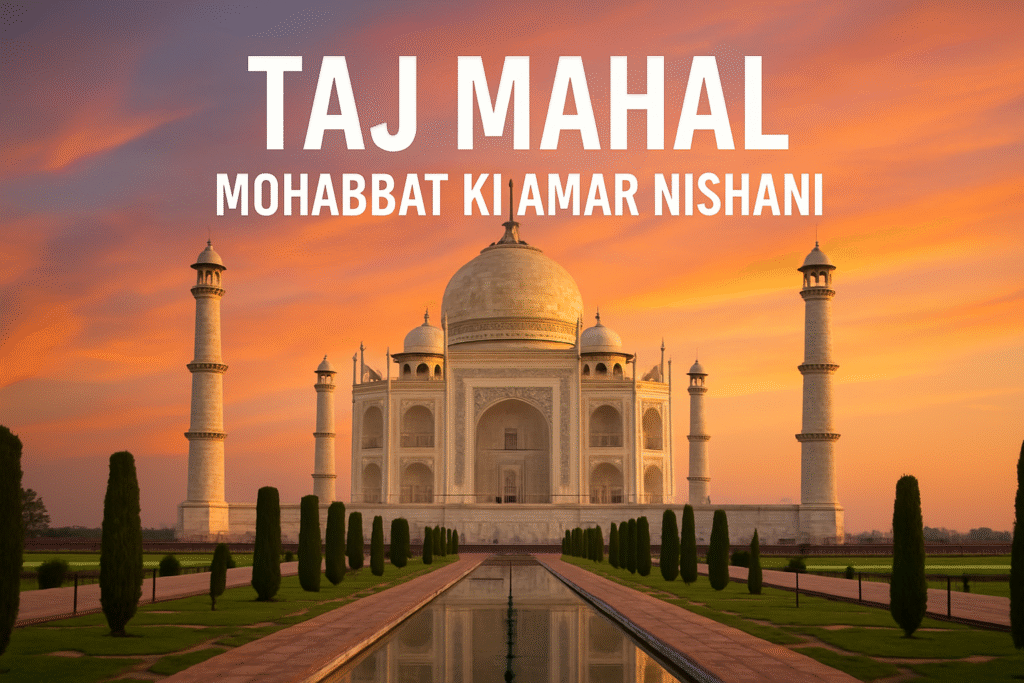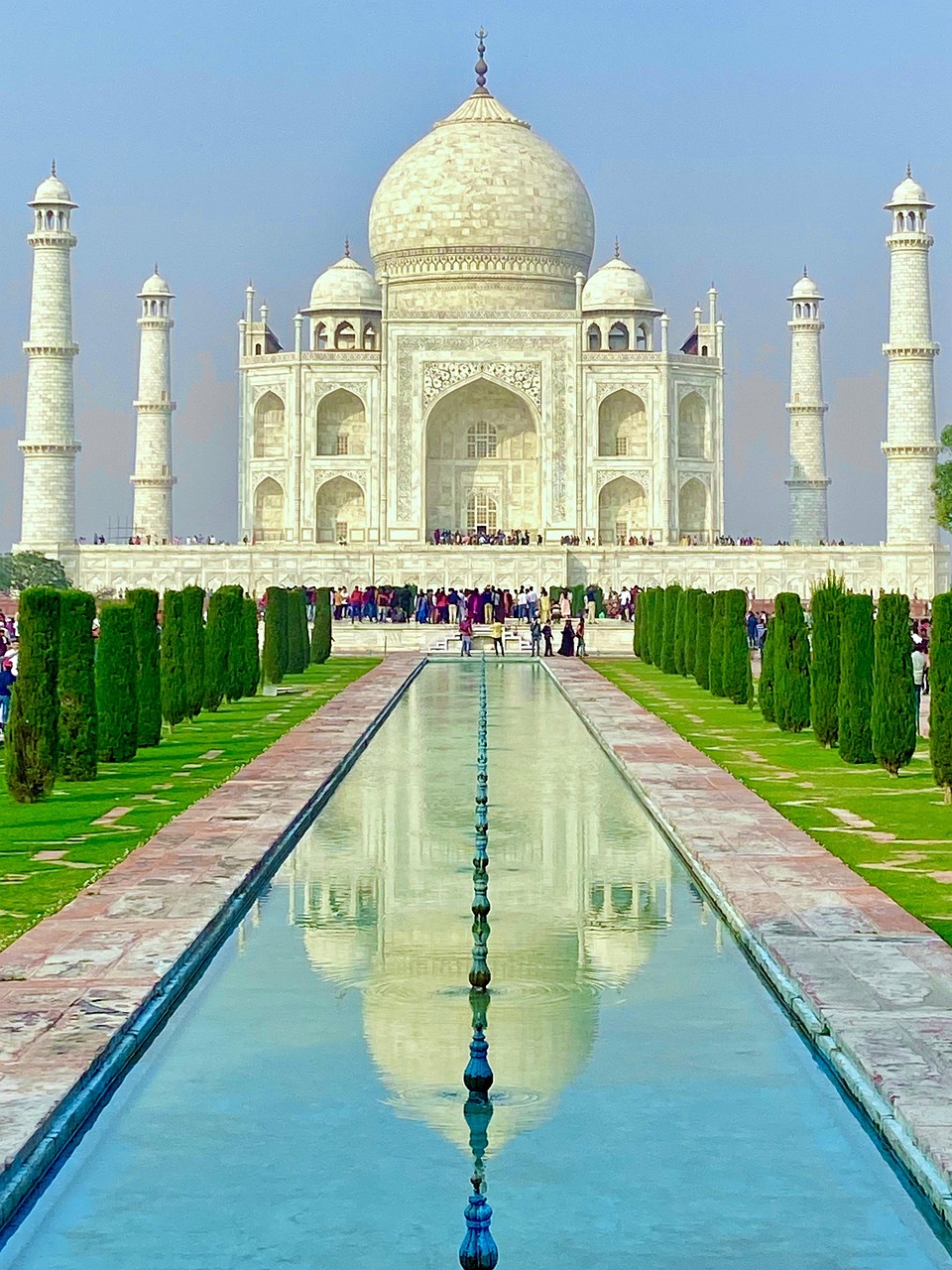Taj Mahal
एक बार की बात है, 17वीं सदी के भारत में, मुग़ल बादशाह शाहजहाँ अपने साम्राज्य के सबसे ताकतवर शासकों में गिने जाते थे।
Once upon a time, in 17th century India, the Mughal emperor Shah Jahan was one of the most powerful rulers of his dynasty.
उनकी बेगम मुमताज़ महल से उनकी मोहब्बत किसी दास्तान से कम नहीं थी।
His love for his wife Mumtaz Mahal was nothing less than a fairytale.
मुमताज़ का मूल नाम अर्जुमंद बानो बेगम था, और वे शाहजहाँ की सबसे प्रिय और नज़दीकी संगिनी थीं।
Mumtaz was originally named Arjumand Banu Begum, and she was the most beloved and closest partner of Shah Jahan.

❤️ प्यार और वादा | Love and the Promise
शाहजहाँ और मुमताज़ के बीच का रिश्ता सिर्फ़ पति-पत्नी का नहीं, बल्कि दोस्ती और इश्क़ का संगम था।
The bond between Shah Jahan and Mumtaz was not just of husband and wife, but also of deep friendship and love.
मुमताज़ ने हर युद्ध और हर यात्रा में शाहजहाँ का साथ निभाया।
Mumtaz stood by Shah Jahan in every battle and every journey.
1631 में, जब मुमताज़ की मौत प्रसव के दौरान हो गई, तो शाहजहाँ की दुनिया बिखर गई।
In 1631, when Mumtaz died during childbirth, Shah Jahan’s world was shattered.
उन्होंने वादा किया कि वो अपनी बेगम की याद में ऐसा मक़बरा बनाएंगे, जिसे पूरी दुनिया याद रखे।
He promised to build a mausoleum in her memory that the world would never forget.
🏗️ ताजमहल का निर्माण | The Construction of the Taj Mahal
ताजमहल का निर्माण कार्य 1632 में आरंभ हुआ और इसे पूर्ण होने में लगभग बाईस वर्ष लग गए।
Work on the Taj Mahal began in 1632 and it took about 22 years to be completed.
इस अद्भुत धरोहर को बनाने में लगभग 20,000 कामगारों और कारीगरों ने अपनी मेहनत लगाई।
Nearly 20,000 workers and craftsmen devoted their efforts to creating this marvel.
संगमरमर राजस्थान के मकराना से मंगाया गया, जबकि अनमोल रत्न और पत्थर फारस, चीन और तुर्की से लाए गए थे।
The marble was brought from Makrana in Rajasthan, while rare gems and stones were imported from Persia, China, and Turkey.
🕌 वास्तुकला और ख़ूबसूरती | Architecture and Beauty
ताजमहल का रंग दिन के समय के साथ बदलता है – सुबह गुलाबी, दोपहर में चमकता सफेद और शाम को सुनहरा।
The Taj Mahal changes colors with time – pinkish at dawn, dazzling white at noon, and golden at dusk.
चार मीनारें, बीच में विशाल गुम्बद और संगमरमर पर की गई नक्काशी इसकी शान बढ़ाती हैं।
Its four minarets, the grand central dome, and intricate marble carvings add to its majesty.
दीवारों पर कुरान की आयतें और फूलों की कारीगरी इसे आध्यात्मिक एहसास देती हैं।
Quranic verses and floral motifs carved on the walls give it a spiritual aura.
🔮 ताजमहल की कहानियाँ और रहस्य | Stories and Mysteries
कहा जाता है कि शाहजहाँ ने कारीगरों के हाथ कटवा दिए ताकि वो ऐसा शाहकार फिर कभी न बना पाएं।
It is said that Shah Jahan had the hands of the artisans cut off so they could never create another masterpiece like this.
हालाँकि, इतिहासकार इस कहानी को मिथक मानते हैं।
However, historians believe this is a myth.
एक और कहानी ये है कि शाहजहाँ यमुना नदी के दूसरी ओर काला ताजमहल बनवाना चाहते थे।
Another story says Shah Jahan planned to build a Black Taj Mahal on the opposite bank of the Yamuna river.
लेकिन औरंगज़ेब ने उन्हें कैद कर लिया और उनका सपना अधूरा रह गया।
But his son Aurangzeb imprisoned him, leaving this dream unfulfilled.
🏰 शाहजहाँ का आख़िरी वक़्त | Shah Jahan’s Final Days
औरंगज़ेब ने शाहजहाँ को आगरा क़िले में कैद कर दिया, जहाँ से वो सिर्फ़ ताजमहल को देख सकते थे।
Aurangzeb imprisoned Shah Jahan in Agra Fort, from where he could only gaze at the Taj Mahal.
आख़िरी सांस तक वो अपनी बेगम की याद में ताजमहल को निहारते रहे।
Until his last breath, he looked at the Taj Mahal, remembering his beloved Mumtaz.
जब शाहजहाँ की मृत्यु हुई, तो उन्हें भी मुमताज़ के बगल में दफ़नाया गया।
When Shah Jahan died, he was buried next to Mumtaz inside the Taj Mahal.
🌍 आज का ताजमहल | Taj Mahal in Present Times
1983 में यूनेस्को ने ताजमहल को विश्व धरोहर स्थल के रूप में मान्यता दी।
In 1983, UNESCO recognized the Taj Mahal as a World Heritage Site.
हर साल करीब 70 लाख पर्यटक ताजमहल देखने आते हैं।
Every year, nearly 7 million tourists visit the Taj Mahal.
फुल मून नाइट पर इसकी खूबसूरती देखते ही बनती है।
On full moon nights, its beauty is beyond imagination.
✨ निष्कर्ष | Conclusion
ताजमहल सिर्फ़ एक मक़बरा नहीं, बल्कि मोहब्बत की वो निशानी है जो समय को मात देती है।
The Taj Mahal is not just a mausoleum, but a timeless symbol of love that defies the ages.
यह हमें याद दिलाता है कि सच्चा प्यार कभी ख़त्म नहीं होता।
It reminds us that true love never dies.

